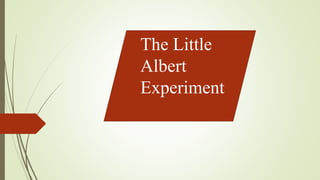
The Little Albert Experiment: Summary, Analysis and Critical Evaluation
- 2. SUBMIT BY: Aliza Riaz
- 3. Agenda To know summary, analysis and critical evaluation
- 4. Summary of The Little Albert Experiment Watson and Raynor presented Little Albert with a white rat and he showed no fear. Watson then presented the rat with a loud bang that startled Little Albert and made him cry. I
- 5. After the continuous association of the white rat and loud noise, Little Albert was classically conditioned to experience fear at the sight of the rat. Albert's fear generalized to other stimuli that were similar to the rat, including a fur coat, some cotton wool, and a Father Christmas mask. II
- 6. Analysis The first major ethical concern we encountered in this exam period was that of Watson and his “Little Albert” study. The modern code of ethics denounces evoking fear responses from human participants, unless the participant has been made aware of and consented beforehand. As an infant, Albert was obviously unable to give consent and also unable to realize that what he was taking part in was controlled research. Scaring a child to the point where he is visibly terrified and crying seems unequivocally immoral. I take more issue with the fact that Watson didn’t remove the fear in Albert by de-conditioning him, even though he had time to allow for it. The impact of the study might justify ethical wrongs it committed. It is one of the most influential studies on phobias of all time, paving the way for counterconditioning (Cover Jones) and other therapies that have allowed millions of people to overcome incapacitating fears and emotional issues
- 7. Analysis While the experiment is one of psychology's most famous and is included in nearly every introductory psychology course, it is widely criticized for several reasons. First, the experimental design and process were not carefully constructed. Watson and Rayner did not develop an objective means to evaluate Albert's reactions, instead of relying on their own subjective interpretations. The experiment also raises many ethical concerns. Little Albert was harmed during this experiment—he left the experiment with a previously nonexistent fear. By today's standards, the Little Albert experiment would not be allowed
- 8. Critical Evaluation The researchers confounded their own experiment by conditioning Little Albert using the same neutral stimuli as the generalized stimuli (rabbit and dog). Some doubts exist as to whether or not this fear response was actually a phobia. When Albert was allowed to suck his thumb he showed no response whatsoever. This stimulus made him forget about the loud sound. It took more than 30 times for Watson to finally take Albert's thumb out to observe a fear response.
- 9. Critical Evaluation Other limitations included no control subject and no objective measurement of the fear response in Little Albert (e.g. the dependent variable was not operationalized). As this was an experiment of one individual the findings cannot be generalized to others (e.g. low external validity). Albert had been reared in a hospital environment from birth and he was unusual as he had never been seen to show fear or rage by staff. Therefore, Little Albert may have responded differently in this experiment to how other young children may have, these findings will therefore be unique to him.
- 10. Critical Evaluation •The Little Albert Experiment was conducted before ethical guidelines were implemented in psychology, and this study can only be judged retrospectively. For example, (i) the experiment was conducted without the knowledge or consent of Albert's parents, (ii) creating a fear response is an example of psychological harm, and finally (iii) Watson and Raynor did not desensitize Albert to his fear of rats.
- 11. ThankYou!